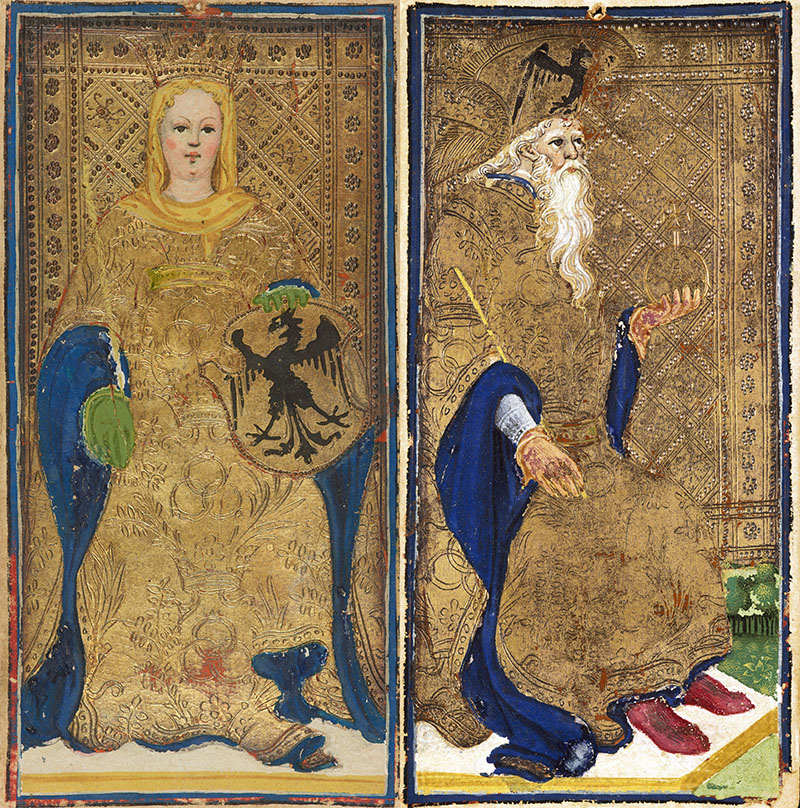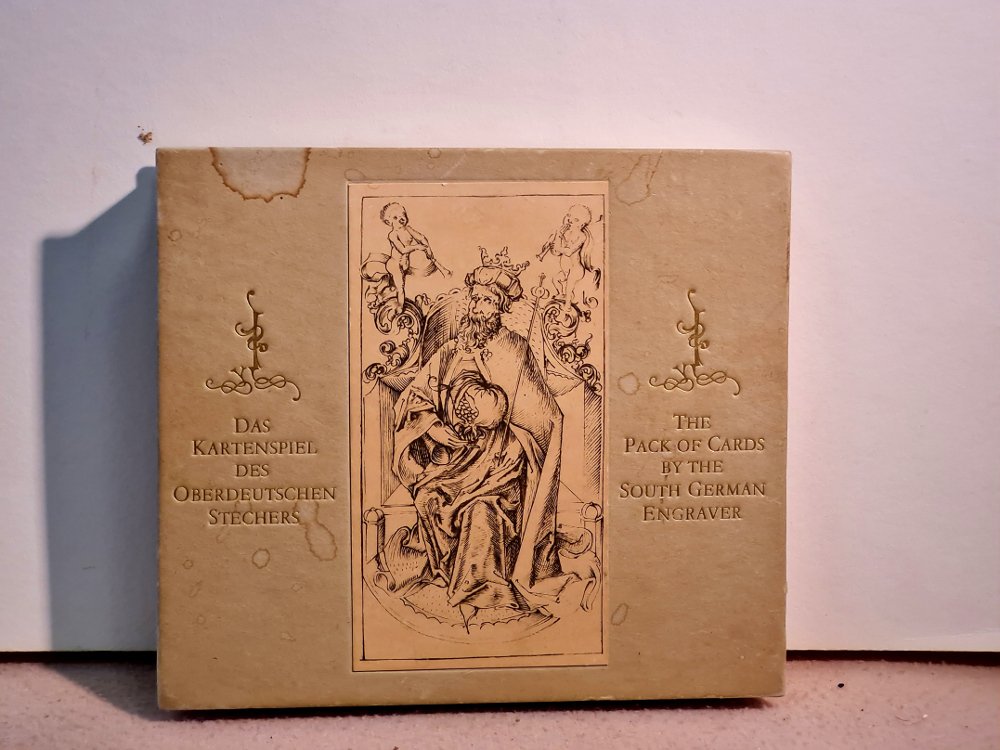To the above, especially in light of the Hofämterspiel King and queen court cards being the only ones on thrones, let me add the chess comparable:Phaeded wrote: 18 May 2022, 21:16How common was that format, both knaves replaced by a woman?Huck wrote: 18 May 2022, 03:50Well, a good observation.Phaeded wrote: 17 May 2022, 00:22 So again, I restate my premise - the only one backed up by the actual surviving cards - that the 8 imperatori resulted from the insertion of the queen, who with the king, represented four houses/suits vying for emperor, and thus "imperatori."
[only king and queen having gold backgrounds in this deck = 8 "gold" cards]Hofjagdspiel suit of falcons.jpg
Another good observation is, that Master Ingold observed 2 decks, which he didn't like.
In one the Ober and Unter are replaced by a Queen and another woman, which Master Ingold dentified as a Mätresse for the King. For this reason Master Ingold doesn't like it. The deck has totally 52 cards.
In the other there were 8 professions, which seem to present a trump order. And 4 kings. Between the 8 professions are a riffian (a pimp) and a täppelweib (a prostitute) and Master Ingold didn't like it.
The insertion of a single queen per suit - no removing of knaves (albeit, one becomes a knight) - is what ends up as the trionfi standard. And to reiterate my notion for the Imperatori, the Unter and Ober knaves are opposed (one with a sign held upwards, the other downwards), so the king could have been paired with the "good knave" to form a group of 8 before the queen was inserted, forming a new group of 8 singularly marked cards: kings and queens.
Queens in early luxury decks from Holy Roman Empire dominions
Stuttgart: 2 suits of 3 males, 2 suits of 3 females; queens only cards singled out with a silver border (deck somewhat matching the CY, which has 3 males and 3 females per suit, vs the 3 males or 3 females).
Hofjagdspiel (courtly hunting deck): King, queen and 2 knaves - only king and queen on gold background.
Hofämterspiel: (courtly household card): Only King and queen court cards, on thrones. What are arguably the knaves - what JvR calls marshalls - have been pushed down into being the 10 and 9 pips, the Hofmeister and Marshal respectively: https://cards.old.no/1455-hofamterspiel/
In this small group of examples we have queen singled out by a precious metal paint (gold or silver) or a throne; even the king is only singled out by a throne or the gold (not the silver in the case of the Stuttgart). In the Hofämterspiel the knaves (now a Master of the house and Marshall), have been pushed down into the pips with the insertion of the queen.
The queen - an innovation from the original Mamluk king/ober/unter format - is arguably the one variable changing the format of playing cards.
Phaeded
In the Book of the Customs of Men and the Duties of Nobles (Liber de moribus hominum et officiis nobilium) or The Book of Chess (De ludo scachorum) derived from these sermons, Cessolis portrayed each station in life, with its particular forms, manners, and duties, starting with the royal pair. 'The King shall sit on a golden chair or a golden throne, a crown upon his head, a scepter in his right hand and an orb in his left. He shall wear a purple cloak and whatever else befits a King.....The Queen shall sit on a golden throne and wear a colored cloak, and whatever else befits a Queen. ( Yalom, Marilyn. Birth of the Chess Queen: A History. 2009: 68-69).
That a series could expand 'on each station of life', as we find in the ps-Mantagna deck, was an idea that was thus there from the beginning but if it were courts commissioning the games then naturally the emphasis fell on the royals; indeed, in Marziano's game for Filippo Visconti the only court card is the King (Beatrice being excised from his imagination, a queen uniquely missing).
And I'm bumping the above in light of Ross's bold assertion in the new Beccadelli thread (and not going to reply there as it would be yet another tangent to that subject line):
The first physical evidence is Rothschild. Their date is hard to pin down, but they bear the unmistakable style of Giovanni dal Ponte, who died before March 1438. The deck has queens, and it has an Emperor. If the date were not controversial, that would be enough to qualify it as a Tarot. If it IS a Tarot, then we have to throw out all of our theories about the influence of Anghiari (you), or the Council (me) on the inspiration for the new game. On the other hand, there is indirect evidence for such a single-Emperor game in the later creation of Fernando della Torre, who studied in Florence in 1432-34, and a 56-card standard pack, i.e. with four court cards including a queen, in Tuscany in Bernardino's sermons of 1425. So the Rothschild cards could be such a single-Emperor game. That is, the Florentines added an Emperor as a trump to their standard cards, and Fernando della Torre, inspired by the game he encountered in Florence in the early 1430s, added an Emperor to the standard Spanish pack in 1450. That's one way to keep the “late invention” of Tarot scenarios alive, and the Rothschild cards can be as old as they (plausibly) like.
Per this thread, the only option for a queen is not just tarot but Imperatori, the only "trump" in fact being the Emperor (and in my view the "queens" would be half a suit couples vying for the emperor spot).
Of some relevance is your research on Torre's odd deck, that's near the PMB date and represents what I was referring to diversity in tarot; from your article:
Again you left out Imperatori, which is surely relevant here since a single Emperor lords above all, and to quote my own take on Imperatori from above, Torres game looks very similar my take on it: "represented four houses/suits vying for emperor, and thus 'imperator'" [the players are hence imperatori]....by his inclusion of a trump card, the Emperor, Fernando indicates that he has either invented the concept of trumps independently of Karnöffel, Marziano da Tortona’s “Sixteen Heroes” game, and Tarot, or, more likely, encountered such an idea during his studies in Florence in the early 1430s.
...content to use the common suit designations, adding only a solitary trump above the suits, and creating different pictures – and thereby stories – for the court cards. Ross Caldwell, "El juego de naypes" of Fernando de la Torre: a fifteenth-century Spanish card game", The Playing Card, vol. 39 no.1 (July-Oct. 2010) pp. 35-56, 33
The unique suit court card identifications nevertheless may reflect some traces of imperatori as the top suit of swords features a male and female pair (the patron abbess and king) while the coin suit seems to offer a negative pairing (a rape victim and adulterer), as well an aspect of tarot per below:
Swords (Espadas / nuns):
King – Abbess of the Monastery of Santa Maria la Real de las Huelgas
Knight – King of Castile
Knave – a procession of gentlemen and ladies in pairs [just as I proposed the Florentine Love card couples - 6 people - get moved to the CY's court cards, Torre has been influenced by a Florentine tradition here but keeps the theme in a single card, as Florentine representations of dancing couples do like a procession; e.g., the famous Adimari cassone: https://www.accademia.org/explore-museu ... e-adimari/
Clubs (Bastones / widows):
King – Pantasilea, Queen of the Amazons
Knight – Judith
Knave – Dido
Cups (Copa / wives):
King – Lucretia (a famous Roman suicide after being raped by Sextus Tarquinius (Tarquin)
Knight – Don Fernán Alonso (infamous for killing his adulterous wife and four others in 1448)
Knave – Paris abducting Helen
Coins (Oros / maidens):
King – The Lady of the Lake
Knight – Ghismonda
Knave – Leander and Hero
At all events, the Rothschild as the earliest tarot is a gigantic IF that doesn't bear weighing in on the ur-tarot discussion if it all rests on the presence of queens.
For the 'standard tarot', we're back to c. 1450, a decade after the ur-tarot. And within the 15th century, 'standard tarot' was never considered inviolate - the expanded tarot (there are cognates for virtually all 22 trumps) of the 'Mantegna Tarocchi' c. 1465 (E-series) and 1470-5 (S-series) and related Lazzarelli poem, Boiardo's poem suggesting largely new trump themes c. 1469, and the 1506 Florentine Mercanzia record of 36 decks of Germini (Minchiate) and tarot (of how many decks of either made up the 36 we do not know, but this does not seem to be a single minchiate deck for an individual, as in the case of Giusti/Malatesta, but an established popular game so that the date of its emergence must be pushed back earlier, by how much we don't know). To refer to Minchiate as "16th century" makes it seem like it was a century away from the ur-tarot when it fact it was more like 60 years, if that, and realistically dating from the very late 15th century. The bottom line is there was a tendency for tarot and tarot-like decks to get more encyclopedic (or lehrgedicht per one German scholar) - expanded - in the late 15th century and early 16th century, not reduced. Why I see a 14 trump ur-tarot being expanded in Milan in the form of the PMB as reflective of that trend.
Phaeded
PS not sure if this been broached on this board, but for the Ludovico Lazzarelli poem, see now Enenkel, K. "Chapter 5 Mythography as Ekphrasis: Ludovico Lazzarelli’s De gentilium deorum imaginibus, and the Poetics of Humanism". In Ekphrastic Image-Making in Early Modern Europe, 1500–1700. Leiden, The Netherlands: Brill.2021: 201–238 and Enenkel, Karl. (2021). Ludovico Lazzarellis Lehrgedicht De gentilium deorum imaginibus. 2021).




